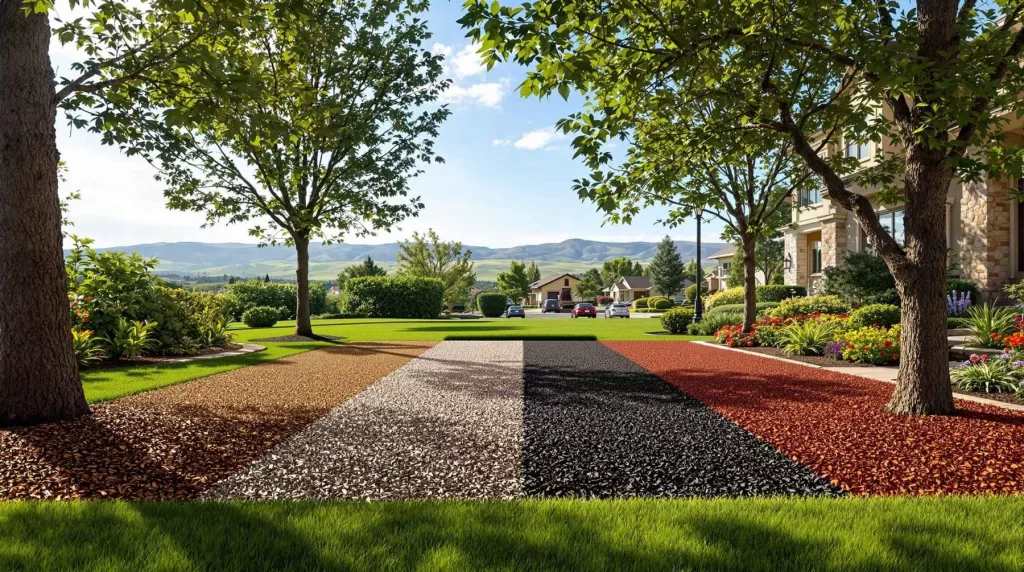
What Type of Mulch is Best for Castle Pines Landscapes?
Introduction Choosing the right mulch is more than just a visual decision — it’s a key part of protecting your plants, conserving water, and keeping
Castle Pines, Colorado, is known for its breathtaking natural beauty, but its high-altitude climate, fluctuating temperatures, and semi-arid conditions can make landscaping a challenge. Native plants offer the perfect solution, thriving in the local environment while requiring less water, fertilizer, and maintenance than non-native species. These plants have adapted to the region’s unique conditions, making them more resilient to drought and temperature extremes while also supporting local wildlife like birds, bees, and butterflies. By choosing native trees, shrubs, flowers, and grasses, homeowners can create a sustainable, low-maintenance landscape that blends seamlessly with the surrounding ecosystem, enhancing both curb appeal and environmental health.
Castle Pines’ high-altitude climate, seasonal temperature swings, and semi-arid conditions make native plants the ideal choice for a thriving, low-maintenance landscape. These plants have naturally adapted to the region, offering resilience against drought, reduced reliance on fertilizers and pesticides, and essential support for local wildlife. By choosing native species, homeowners can enjoy a sustainable, visually appealing yard that conserves water and enhances the natural ecosystem without constant upkeep. For a professionally designed native landscape tailored to Castle Pines’ climate, explore our Castle Pines Landscaping services.
Native plants in Castle Pines have evolved to withstand extreme temperature fluctuations, intense sun exposure, and periods of drought. Their deep root systems allow them to access water efficiently, making them well-suited to Colorado’s dry conditions. Hardy species like Ponderosa Pine and Blue Grama Grass thrive with minimal irrigation, maintaining their health and vibrancy even in challenging weather.
Unlike non-native plants that often require chemical treatments and frequent watering, native plants naturally resist local pests and diseases while thriving in Castle Pines’ soil. Their low water requirements make them an excellent choice for homeowners looking to reduce irrigation costs and support Colorado’s water conservation efforts. By integrating native trees, shrubs, and grasses, homeowners can create a self-sustaining landscape that remains lush and healthy with minimal intervention.
Incorporating native plants into your landscape helps maintain a balanced ecosystem by providing food and shelter for birds, butterflies, bees, and other pollinators. Wildflowers like Rocky Mountain Columbine and Blanket Flower attract beneficial insects, while native shrubs and trees offer nesting spaces for local wildlife. By planting a variety of native species, homeowners can create a thriving habitat that contributes to biodiversity and promotes a healthy, vibrant environment.
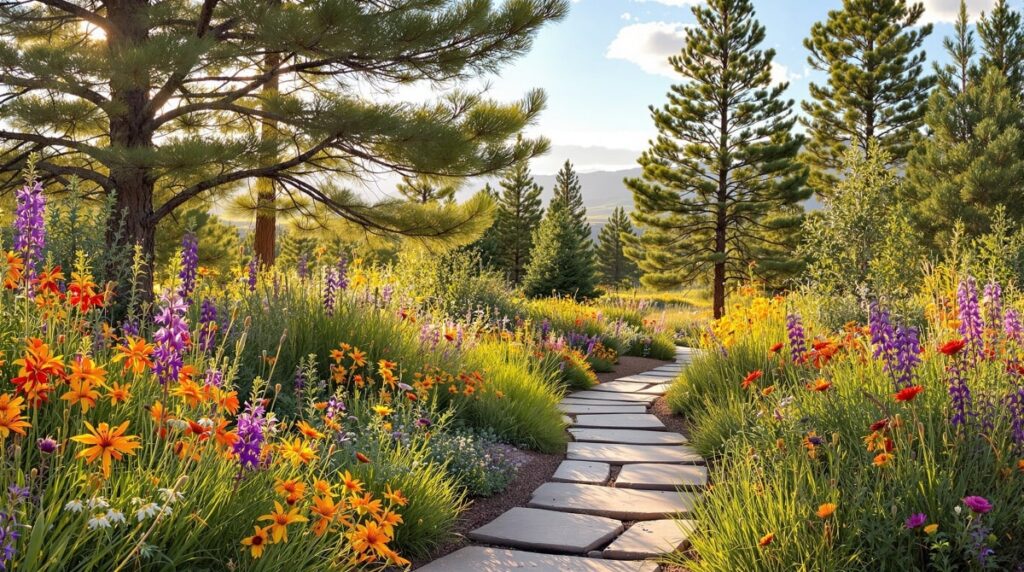
Choosing the right native plants can transform a Castle Pines landscape into a thriving, low-maintenance, and visually striking outdoor space. Native trees, in particular, provide essential shade, enhance aesthetic appeal, and contribute to a healthier ecosystem. These trees are naturally adapted to Colorado’s high-altitude climate, requiring minimal water while withstanding temperature extremes. Whether you’re looking for year-round greenery, seasonal color, or fast-growing species, these native trees are excellent choices for a sustainable and beautiful landscape. Not sure which native plants will work best for your property? Our Castle Pines Landscaping experts can help you select the perfect trees, shrubs, and flowers for a thriving landscape.
Native trees offer both practical and aesthetic benefits, creating a natural canopy that provides cooling shade in the summer and wind protection in the winter. Their deep root systems help prevent soil erosion while requiring far less irrigation than non-native species. By selecting trees that thrive in Castle Pines’ environment, homeowners can enjoy a landscape that remains healthy and vibrant with minimal maintenance.
A staple of Colorado’s forests, the Ponderosa Pine is a resilient evergreen that can withstand Castle Pines’ dry conditions and fluctuating temperatures. Its tall, straight trunk and distinctive reddish-brown bark make it a striking addition to any landscape. This low-maintenance tree requires little water once established and provides excellent shade and wind resistance, making it a functional and visually appealing choice for homeowners.
Ideal for smaller landscapes, the Rocky Mountain Maple offers stunning seasonal interest with its bright green summer leaves turning fiery shades of red and orange in the fall. This hardy tree thrives in Castle Pines’ well-drained soils and provides valuable habitat for birds and pollinators. Its compact size makes it an excellent choice for adding color and texture without overwhelming the space.
Known for its shimmering leaves and striking white bark, the Quaking Aspen adds a unique visual element to any landscape. It is one of the fastest-growing native trees in Colorado, making it ideal for homeowners looking to establish shade quickly. Aspens thrive in clusters, creating a natural woodland feel while supporting local wildlife. Their adaptability and aesthetic appeal make them a favorite among Castle Pines residents
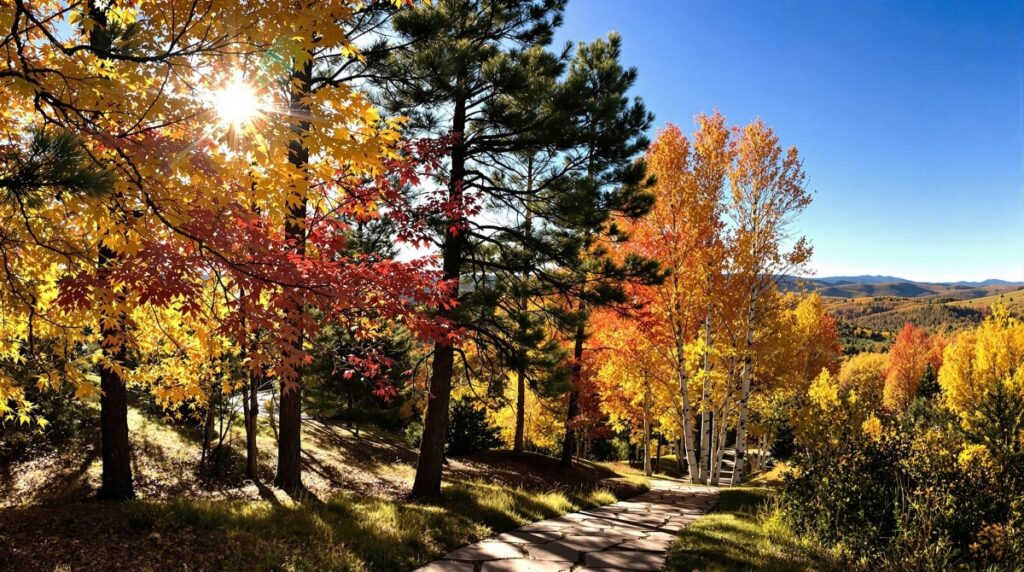
Native shrubs play a vital role in Castle Pines landscaping by providing structure, seasonal color, and natural privacy screening. Unlike traditional hedges that may require frequent trimming and irrigation, native shrubs are naturally adapted to Colorado’s semi-arid climate, making them low-maintenance and highly resilient. These shrubs offer a variety of benefits, from attracting pollinators with fragrant blooms to enhancing fall landscapes with rich, colorful foliage. By incorporating native shrubs, homeowners can create a layered, dynamic landscape that remains visually appealing throughout the year.
Three-Leaf Sumac is a drought-tolerant shrub known for its brilliant red, orange, and yellow fall colors, adding a burst of warmth to autumn landscapes. Its small, dark green leaves create a dense, bushy form that provides excellent erosion control on slopes and rocky terrain. This hardy shrub requires little water once established and thrives in Castle Pines’ dry, well-drained soils, making it a stunning and practical choice for year-round interest.
Mountain Mahogany is a rugged, drought-resistant shrub that thrives in Castle Pines’ harsh conditions. Its glossy green leaves remain attractive through summer before turning golden in the fall. The real highlight of this shrub is its distinctive seed plumes, which appear in late summer and persist into winter, adding a unique textural element to the landscape. This resilient plant also helps stabilize soil and supports local wildlife, making it both functional and beautiful.
A versatile shrub with multiple seasonal highlights, the Western Sandcherry is prized for its fragrant white spring flowers, lush summer foliage, and deep purple berries in late summer. The berries attract birds and can even be harvested for jams or fresh eating. This hardy shrub tolerates drought and poor soils while adding ornamental beauty and ecological value to any Castle Pines landscape. With its low-growing, spreading habit, it works well as a border plant or accent in native gardens.
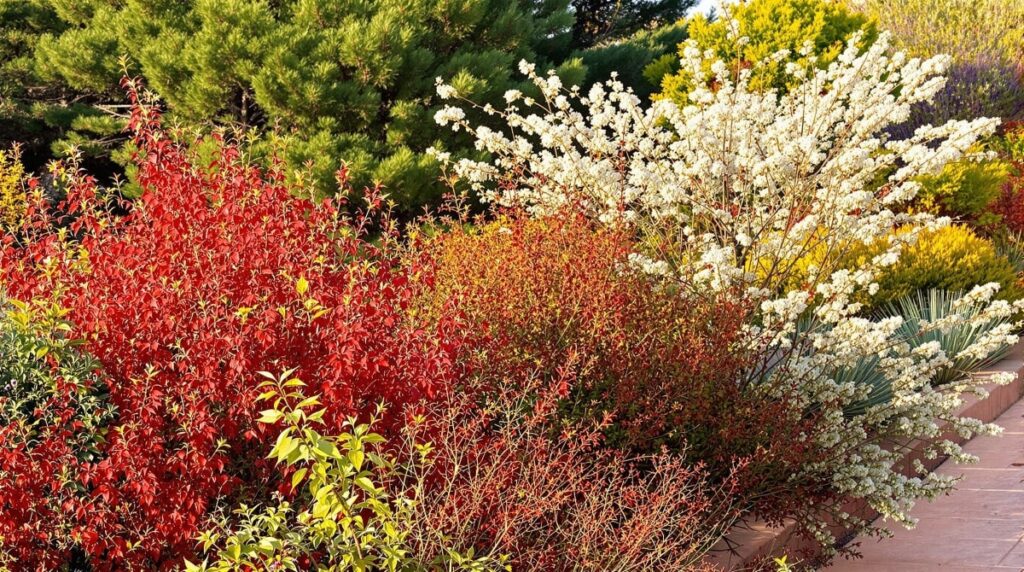
Perennials and wildflowers bring vibrant color, texture, and biodiversity to Castle Pines landscapes while requiring minimal maintenance. These native flowering plants are well-adapted to Colorado’s high-altitude environment, thriving in dry conditions and supporting essential pollinators like bees, butterflies, and hummingbirds. By incorporating a mix of native perennials, homeowners can enjoy a constantly changing display of blooms throughout the growing season while creating a habitat that benefits local wildlife.
The Rocky Mountain Columbine is one of the most iconic wildflowers in Colorado, prized for its delicate, blue-and-white petals and elegant, nodding blooms. This shade-loving perennial is perfect for woodland gardens or areas with filtered sunlight, adding beauty to rocky or forested landscapes. Its nectar-rich flowers attract hummingbirds and bees, playing a crucial role in supporting local pollinators. Easy to grow and naturally adapted to Castle Pines’ elevation, the Rocky Mountain Columbine is a must-have for native plant gardens.
Blanket Flower is a striking native wildflower known for its fiery red, orange, and yellow petals that resemble a sunburst. This long-blooming perennial thrives in full sun and poor, dry soils, making it an excellent choice for Castle Pines’ climate. Highly attractive to butterflies and bees, Blanket Flower enhances the ecological balance of a garden while providing continuous color from late spring through fall. Its drought tolerance and ability to reseed naturally make it a low-maintenance favorite for wildflower meadows and pollinator gardens.
For late-season color and pollinator support, Blue Mist Spirea is an excellent choice. Its soft, blue-purple blooms emerge in late summer and continue into early fall, providing a crucial nectar source for bees and butterflies when other flowers have faded. This compact, drought-tolerant shrub-like perennial thrives in well-drained soils and full sun, adding both structure and visual interest to a landscape. With its airy, mist-like flowers and aromatic foliage, Blue Mist Spirea is an attractive and functional addition to any Castle Pines garden.
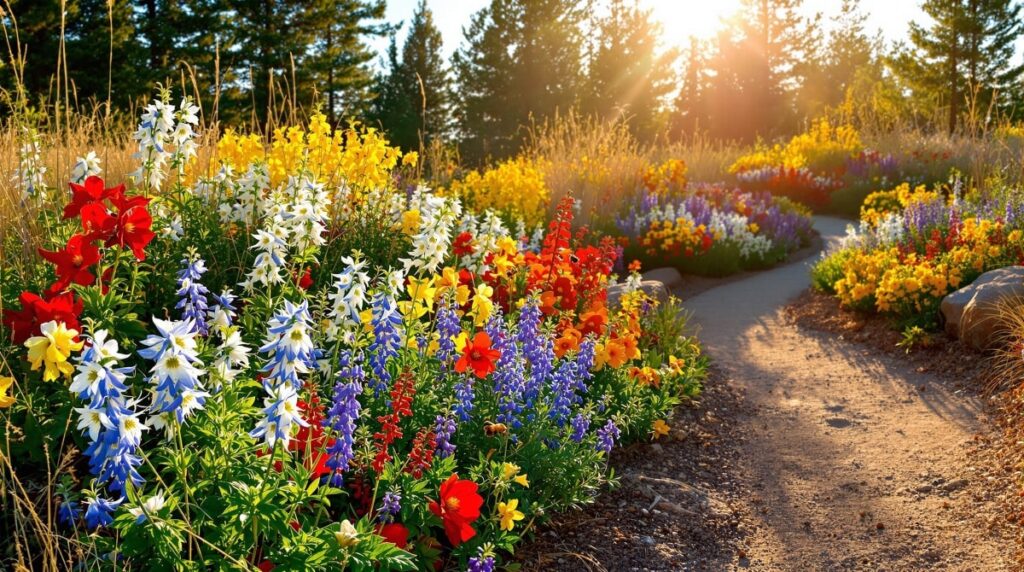
Native grasses and ground covers are essential for stabilizing soil, preventing erosion, and adding visual interest to Castle Pines landscapes. These plants are naturally adapted to Colorado’s dry conditions and rugged terrain, requiring minimal water while providing year-round beauty. From soft, swaying grasses that bring movement to the landscape to hardy ground covers that fill in bare spaces, these native selections enhance both aesthetics and functionality while supporting local ecosystems.
As one of Colorado’s most iconic native grasses, Blue Grama Grass is highly drought-tolerant and thrives in Castle Pines’ semi-arid conditions. Its delicate seed heads, which resemble eyelashes, add a unique texture to the landscape and create a soft, flowing movement when swayed by the wind. This low-maintenance grass requires little irrigation and provides excellent ground coverage, making it an excellent choice for natural meadows, xeriscapes, and erosion control.
Little Bluestem is a standout native grass known for its striking blue-green summer foliage that transitions to deep red and bronze hues in the fall. Its strong, fibrous root system helps prevent soil erosion, making it an excellent choice for slopes and areas prone to runoff. This hardy grass thrives in dry conditions and adds year-round texture and color to Castle Pines landscapes while also providing habitat for native birds and insects.
For homeowners looking to replace traditional lawns or fill in difficult-to-landscape areas, Sulphur Flower is a perfect native ground cover. This tough, low-growing perennial features clusters of bright yellow flowers that bloom in late spring and summer, attracting pollinators while adding seasonal color. Its dense mat-like growth helps suppress weeds and retain soil moisture, making it an ideal solution for rock gardens, dry slopes, and xeriscape designs in Castle Pines.
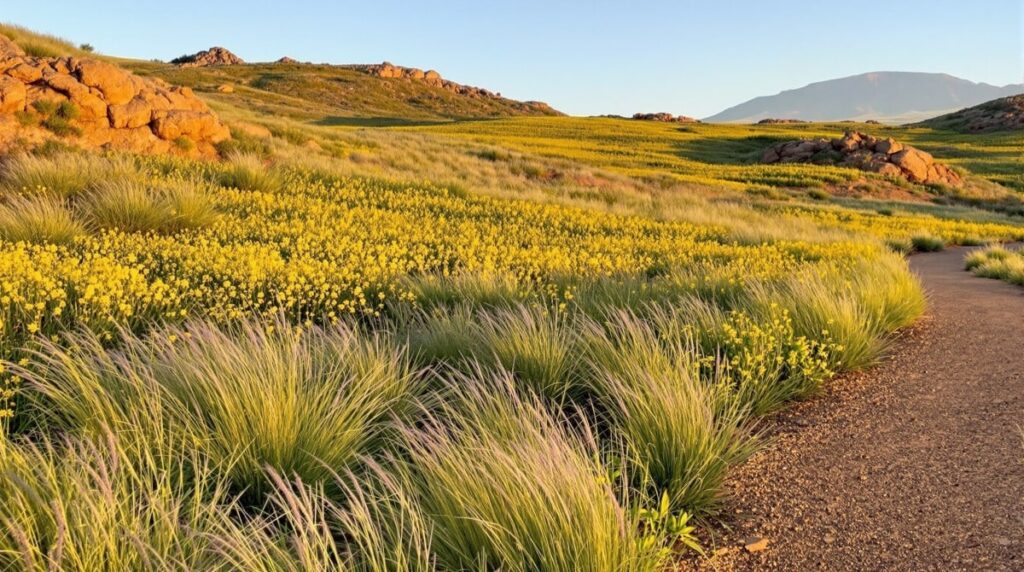
Proper planting and maintenance techniques are essential for ensuring the long-term health and vitality of native plants in Castle Pines. While these plants are naturally suited to Colorado’s climate, establishing them correctly can improve their resilience and enhance their ability to thrive with minimal intervention. From soil preparation to strategic watering and seasonal care, following best practices will help create a flourishing, sustainable landscape that requires little upkeep while providing lasting beauty and ecological benefits. Proper planting and soil preparation are key to long-term success. Let our Castle Pines Landscaping team handle the details for a sustainable, low-maintenance yard.
Healthy soil is the foundation of a thriving native landscape. Before planting, it’s essential to assess soil type and improve drainage if necessary, especially in areas with compacted or clay-heavy soils. Many native plants prefer well-draining, slightly rocky soils that mimic their natural habitat. Incorporating organic matter or using raised beds can help improve growing conditions where needed. Applying organic mulch around plants helps retain moisture, suppress weeds, and regulate soil temperature, reducing the need for frequent watering while supporting root development.
Although native plants are drought-tolerant once established, they require proper watering during their initial growth phase. Deep watering techniques encourage strong root development by directing moisture deeper into the soil, reducing surface evaporation and promoting long-term resilience. Over time, many native species can transition to relying primarily on natural precipitation, significantly reducing irrigation needs. Drip irrigation or soaker hoses can be used sparingly during prolonged dry periods to supplement rainfall while maintaining water efficiency.
Native plants generally require minimal pruning, but strategic trimming can enhance their shape, encourage healthy growth, and remove dead or damaged branches. The best time to prune depends on the plant species, but late winter to early spring is ideal for most native shrubs and trees before new growth begins. Additionally, young plants may require some winter protection, such as mulch insulation around their base, to help them withstand freezing temperatures. Avoid excessive trimming, as many native plants have natural growth habits that contribute to their drought resistance and ecological benefits.
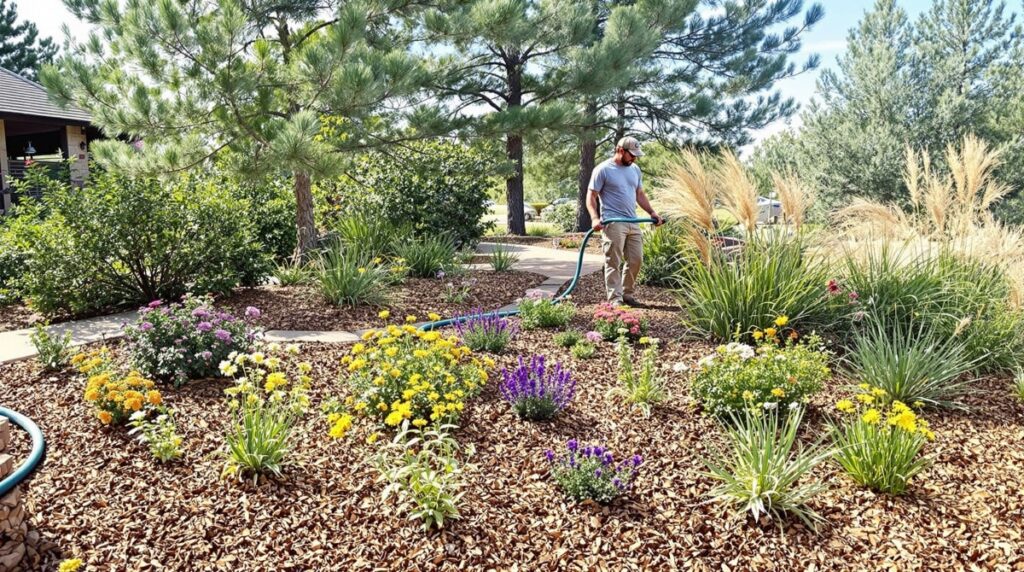
A well-designed native landscape blends beauty with sustainability, creating an outdoor space that is both visually appealing and environmentally functional. By strategically layering native trees, shrubs, and perennials, homeowners can enhance depth, texture, and seasonal color while minimizing maintenance. Thoughtful plant placement also supports local wildlife, and incorporating xeriscaping principles ensures a water-efficient landscape that thrives in Castle Pines’ semi-arid climate. With the right design approach, a native garden can be both a stunning focal point and a resilient, self-sustaining ecosystem. A well-designed landscape not only looks beautiful but also functions efficiently. Our Castle Pines Landscaping services specialize in creating native landscapes that enhance curb appeal and support the environment.
One of the key principles of landscape design is layering plants to create a balanced and natural aesthetic. By placing taller native trees in the background, medium-sized shrubs in the mid-level, and colorful perennials in the foreground, homeowners can achieve depth and structure in their outdoor space. This approach maximizes seasonal color, ensuring that different plants bloom at various times throughout the year. Using a mix of textures, from the delicate foliage of native wildflowers to the sturdy branches of drought-tolerant trees, enhances visual interest and makes the landscape feel dynamic and complete.
A well-planned native landscape provides food, shelter, and nesting sites for local wildlife, including birds, butterflies, and beneficial insects. Grouping pollinator-friendly plants like Rocky Mountain Columbine and Blanket Flower together creates a reliable nectar source for bees and hummingbirds. Meanwhile, placing shrubs like Three-Leaf Sumac or Mountain Mahogany along property edges offers natural cover for birds. By designing the landscape to mimic natural plant communities, homeowners can contribute to a thriving ecosystem while enjoying the sights and sounds of wildlife in their backyard.
Xeriscaping, a landscaping approach designed for water efficiency, is particularly well-suited for Castle Pines’ dry climate. By combining native drought-tolerant plants with rock features, mulch, and efficient irrigation techniques, homeowners can create a low-maintenance yard that minimizes water use while maintaining a beautiful aesthetic. Strategic placement of gravel or stone pathways can reduce the need for traditional turf, while organic mulch around plants helps retain moisture. A well-designed xeriscape balances form and function, ensuring that the landscape remains lush and inviting without excessive irrigation.
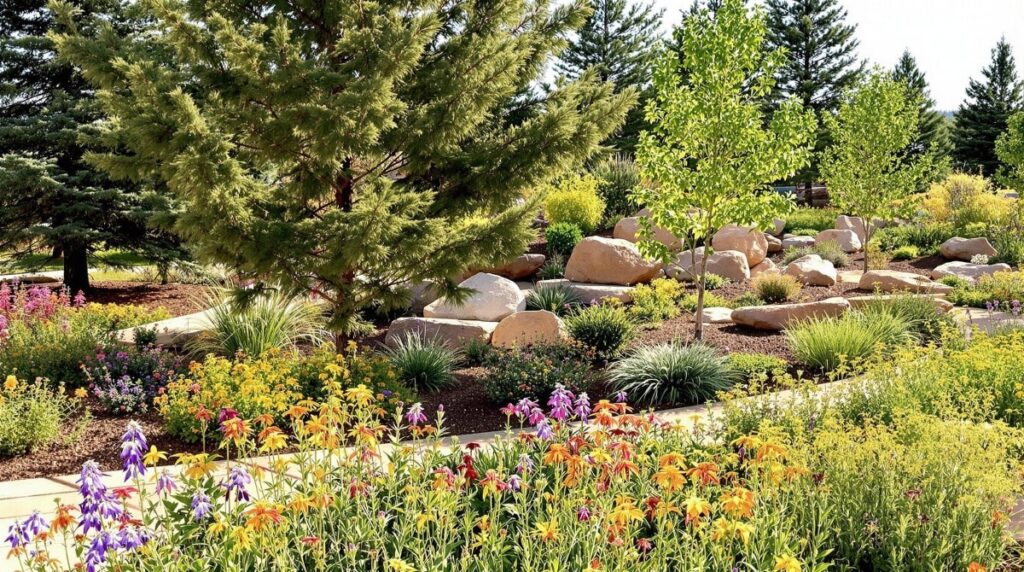
Integrating native plants into your Castle Pines landscape is one of the best ways to create a thriving, sustainable, and visually stunning outdoor space. These plants are naturally adapted to the region’s climate, offering resilience against drought, minimal maintenance requirements, and essential support for local wildlife. By carefully selecting and strategically placing native trees, shrubs, wildflowers, and grasses, homeowners can enjoy year-round beauty while conserving water and enhancing ecological health. Whether you’re looking to add vibrant seasonal color, create a wildlife-friendly habitat, or design a low-maintenance xeriscape, native plants provide endless benefits. To ensure the best results, consult with a local landscaping expert who can guide you in selecting and installing the right native species for your property, helping you build a landscape that is both functional and breathtaking for years to come. At Custom Landscapes by Design, we specialize in crafting stunning, sustainable landscapes that thrive in Colorado’s unique climate. Contact us today to bring your vision to life.

Introduction Choosing the right mulch is more than just a visual decision — it’s a key part of protecting your plants, conserving water, and keeping

Introduction Castle Pines is home to some of the most breathtaking properties in Colorado — and luxury homeowners here expect nothing less than perfection in
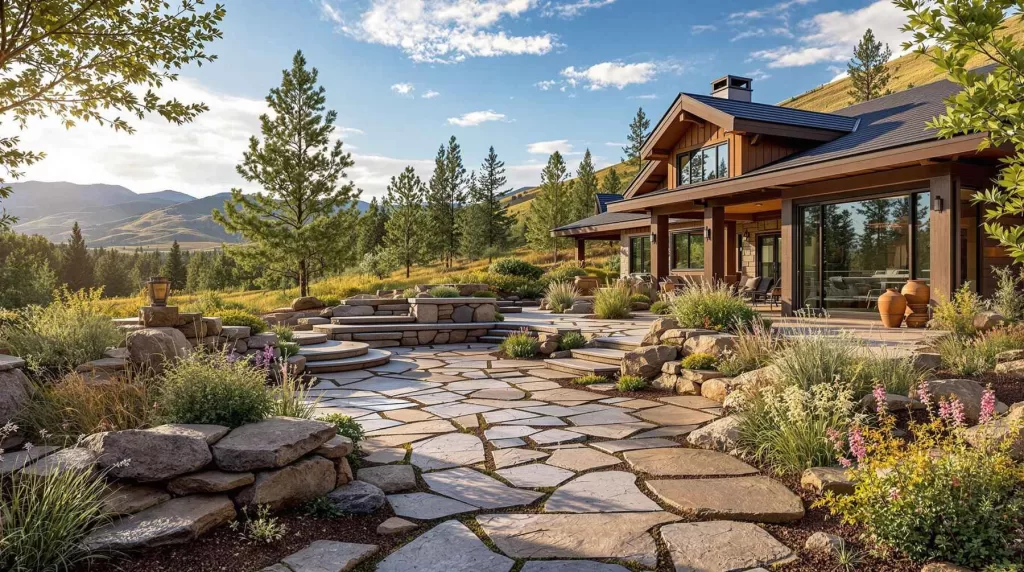
Introduction Natural stone has long been a favorite among Colorado homeowners for its durability, timeless appeal, and ability to blend seamlessly into natural surroundings. In
Fill out your details below and we will reach out to you for a free consultation!
Monday 9 AM – 5 PM
Tuesday 9 AM – 5 PM
Wednesday 9 AM – 5 PM
Thursday 9 AM – 5 PM
Friday 9 AM – 5 PM
Saturday: By Appointment Only
Sunday: Closed